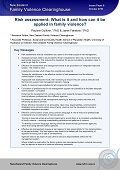 Issues Paper 9, October 2015
Issues Paper 9, October 2015
Authors: Pauline Gulliver1, PhD and Janet Fanslow2, PhD
1 Research Fellow, New Zealand Family Violence Clearinghouse
2 Associate Professor, Social and Community Health, School of Population Health, University of Auckland; Co-Director, New Zealand Family Violence Clearinghouse
Downloads
Key messages
- Risk assessment must be considered as a piece in the wider puzzle of risk management.
- Adequate services need to be provided for those considered at “less” risk, so they receive an appropriate response. This also reduces the imperative for service providers to escalate a case, in order to get help for a person.
- Effective risk assessment and management needs to be grounded in an integrated response system. This needs to have:
- Underlying principles which shape how practitioners respond.
- Training for practitioners in the effective conduct of risk assessment and the effective communication of results.
- Appropriate risk assessment tools should be selected, with monitoring to ensure they are used as intended and that they support risk management decision making.
- Clarity of roles and responsibilities for all components of the system. - Co-location of professionals for risk management appears very beneficial to facilitate adequate communication. Co-location:
- Enhances the development of a unique culture which supports increased trust and information sharing between professionals from different agencies.
- Facilitates the process of risk management planning by reducing turnaround times and enhancing access to services.
- Where effective colocation is not achievable, clear roles, responsibilities, communication strategies and a common culture around family violence must be developed to ensure a consistent response is provided. - Effective communication of risk, using common language, is vital to ensure all professionals understand how an estimation of risk was derived.
- Training is required across government agencies to ensure there is a consistent understanding of family violence – including understanding definitions and patterns of violence.
- To develop a common language, training should be shared across government agencies, rather than being delivered within agencies. - Effective risk management requires a lead agency to take responsibility for the implementation of planned activities. This lead agency also needs to be tasked with the responsibility of regularly reviewing risk in light of developments.
- Agencies need to be aware of each other’s roles and responsibilities within the risk management system.
- Where limitations exist within the family violence risk management system, external resourcing may be required to ensure all risks are effectively addressed.
Recommended citation
Gulliver, P., & Fanslow, J. (2015). Risk assessment: What is it and how can it be applied in family violence? Auckland, New Zealand: New Zealand Family Violence Clearinghouse, University of Auckland.
ISSN: 2253-3222, published online only.
Feedback
The Clearinghouse welcomes your feedback. Please email us - we would love to hear your comments on this issues paper.


